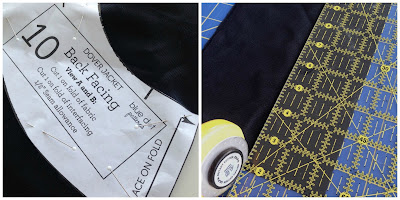It's day #3 of the Dover Jacket Sew-Along and we are taking our jacket to the machine today as we construct the body of our garment. We will learn how to make even gathers, the importance of clipping and understitching (what is it?)
Pull out the instructions for View B, we are taking this one step at a time. Keep in mind, all seam allowances are 1/2" and I am using a serger to finish my seams. Pick whatever seam finish works best for you.
To begin, staystitch the neckline of the fronts, back and sleeves using a regular straight stitch at the 1/2" seam line:
Sewing Skill #3 - Gathering
On both fronts and on the back, make two rows of stitching between the notches. Use long stitch length (a 4 or 5 on most machines) and stitch 1/2" from raw edge and again 3/8" from raw edge. Leave the thread tails long.
With right sides together, pin the upper front to the front, pinning at edges and notches only. Don't add any other pins at this point (don't worry that the raw edges don't match up). Grab two thread tails (from the long stitches you made earlier) and gently pull them so the fabric gathers up to fit along the upper front.
At both notches, anchor the threads by wrapping in a figure 8 shape around the pin (this will keep your gathers from "falling off"). Now that your stitches are anchored, you can move the fabric along the threads to make them even. Pin every 1" along gathers.
Stitch in place.
Repeat for other front and back. Press seams up.
With right sides together, stitch front to sleeves at armholes seams. Repeat for back. Press seams toward sleeve.
To make sleeve dart, put dart legs right sides together and stitch in place, sewing all the way to the point of the dart. Press darts toward the back (using a pressing ham will help when pressing the dart).
With right sides together, stitch front to back at sides, from the end of the sleeve to the jacket hem. Press seams toward the back.
Your jacket is already looking like a jacket, right?
With right sides together, stitch front facing to back facing at neck seams.
Pin facing to jacket, right sides together. Stitch in place, pivoting at the top of the neck.
Sewing Skill #4 - Clipping
Clipping is another one of the those skills sewers want to skip but seriously folks, there is no other way to make a curve lie flat. So whenever you have a curve, take the end of your scissors and cut through the seam allowance (clip) to the stitching line but not through the stitch. The tighter the curve, the closer together your clips need to be.
On your jacket, trim the seam allowance to 3/8" and clip the corners off at the top of the neck at your pivot.
Clip along the neckline edge about every 1". Flip facing to the inside.
Is it lying flat around the curve? If not, you may need a few more clips. Press the facing in place.
Enjoy your handiwork, it's looking' good!
Sewing Skill #5 - Understitching
Now I know plenty of people that have been sewing for years and have never understitched. It's one of those skills that can change a garment from looking homemade to professional and it's really simple.
An understitch is a line of stitching close to the neckline edge on the facing. It makes a facing want to lie flat. I don't know the physics of it but I know it works.
To understitch, make a line of stitching 1/8" from the neckline edge
through the facing and all seam allowances but leaving the jacket front free. I use a ditch foot to help me stay straight but you can use a regular machine foot.
On the Dover Jacket, understitch from the hem of the jacket as far up the front as possible (you can't stitch all the way because of the corner), continue around the neckline as far as possible and finish up stitching from the neck down to the hem.
Flip your facing back and see how beautiful it is. You can use this technique around necklines, at waistbands and near linings. I find most of my projects have an area that would benefit from understitching.
We are powering through this Sew-Along and we will finish it up in our next installment. Dover Day #4 is February 23. Keep asking questions! I'm happy to help.
Thanks for sewing along!





















































